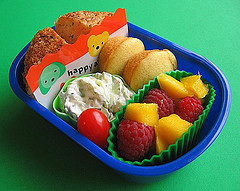Bentos and the picky eater
With all the recent hubbub over Deceptively Delicious , Jessica Seinfeld’s cookbook for smuggling veggies into children’s food, I’ve been thinking about the different ways parents try to get their kids to eat a variety of foods. (Details here about the accusations of plagiarism from the author of similar book The Sneaky Chef .) There are two schools of thought: 1) sneak healthy food into things that kids already like (i.e. put pureed spinach into brownies), vs. 2) get kids used to eating adult food and expose them repeatedly to many different foods. CityMama’s post describes the approach she’s taken with her kids: make food as delicious as possible, give them adult food to develop their palates, and involve them in the cooking process.
This is what we’ve done with our son. Obviously he’s not a picky eater, so we’ve been fortunate in being able to just give Bug whatever we eat within reason (i.e. toning down spiciness where necessary). But I’m wary of being smug and getting up on a soapbox about how to raise your child, because one of our friends has done all of the same things with her daughter that we have, but wound up with an extraordinarily picky eater. You know, nothing can be mixed, meat must be identifiable and on the bone (chicken drumsticks only, not slices of chicken), most vegetables are out, etc. This child keeps me humble — I feel for her food adventurer parents!
Evidently picky eating in childhood may be a result of genetics, though, not just the environment. A New York Times article on picky eaters cites a study by University College London, saying that picky eating in childhood is 78% genetic and 22% environmental. This actually makes a lot of sense to me — it would explain our friends’ picky daughter.
If you do have a picky eater, though, bento lunches can help coax your child to take a bite. Keep in mind:
- Don’t overpack. Too much food in a lunch can overwhelm a child, so try to pack a lunch they can finish in the time available. These bento box size guidelines provide a chart with box size by age and gender; pack the box compactly and fill gaps to keep the lunch arrangement stable during transport.
- Don’t overdo new foods in a bento. Educating the palate is great, but balance the introduction of new or unfavored foods with items you know your child likes.
- Make it fun. This is where bento lunches can really shine, with containers and food itself in a wide variety of colors, sizes and shapes.
- The food: There are so many ways to make food fun! You can make miniature versions of regular food when making dinner (mini muffins, baby vegetables, mini burgers, cocktail sandwiches, mini frittatas, tiny shepherd’s pies), create food art with little cutters and shaped food (molded hard-boiled eggs), put together do-it-yourself dishes that are assembled or dipped just before eating, etc. Even something as simple as slicing fruit differently can make the difference between a couple of bites and a flat-out “No.” Packing a variety of contrasting colors, textures and shapes in a bento adds to the visual appeal when the lid is removed. No need to go overboard here if you’re pressed for time, just try to avoid an all-brown mushy lunch if you can.
- The gear: Bento boxes come in endless designs, from plain to favorite cartoon characters, or you can use stickers and markers to personalize widely available containers like Lock & Lock boxes. Accessories such as food picks, baking cups (colorful silicone or paper), little sauce containers, and food dividers (edible or plastic) add color and fun — eating lunch almost becomes play instead of grounds for conflict.
- Reduce meal frustration for younger children. Make sure they can open all of their containers by themselves, cut large food into bite-size pieces, separate food with baking cups or food dividers if your child is sensitive to food touching, or even have a practice run with new gear before using it for the first time. This is how I discovered that one of our oshibori hand towel cases was impossible for Bug to open on his own.
- Involve your child. Keep the lines of communication open — talk about lunch food, take them shopping with you if you can, and make time to let them help in the kitchen. Okay, getting “help” with every single meal or shopping trip isn’t realistic, but you can help make meals more interesting and participatory. The Spatulatta cooking website for kids currently has five new bento-themed videos that make bento food prep fun and accessible. Enjoy!
READ MORE:






Recent Comments
Poll: What bento information interests you? (29)
Jenifer |
FAQRichard Malakuskie | The Nerdie Birdie | Shaking up the Lunch Routine: Popcorn with Toppings - Popcorn Blog | Justin Wright |
Oshibori: We don’t need no stinking wet wipes!Daniel |
Homemade gnocchi box lunches (22)Lisa |
Guide to choosing the right size bento box (82)Julie |
Confessions of an ostrichBernice |
Top Tips (4)miamidish.net | Cheap Seat Eats |
How to make Spam Musubi (69)Scratching Ramen |
School auction bentos with stuffed mushrooms (8)Marci |
Speed Bento: leftover storage and portion guidelinesAdverbios de tiempo |
Fried Shrimp Bentos: Simple vs. Fancy (43)Mimi |
Fruit cup jello jigglers in everyday containers (42)Madison Moms Blog |